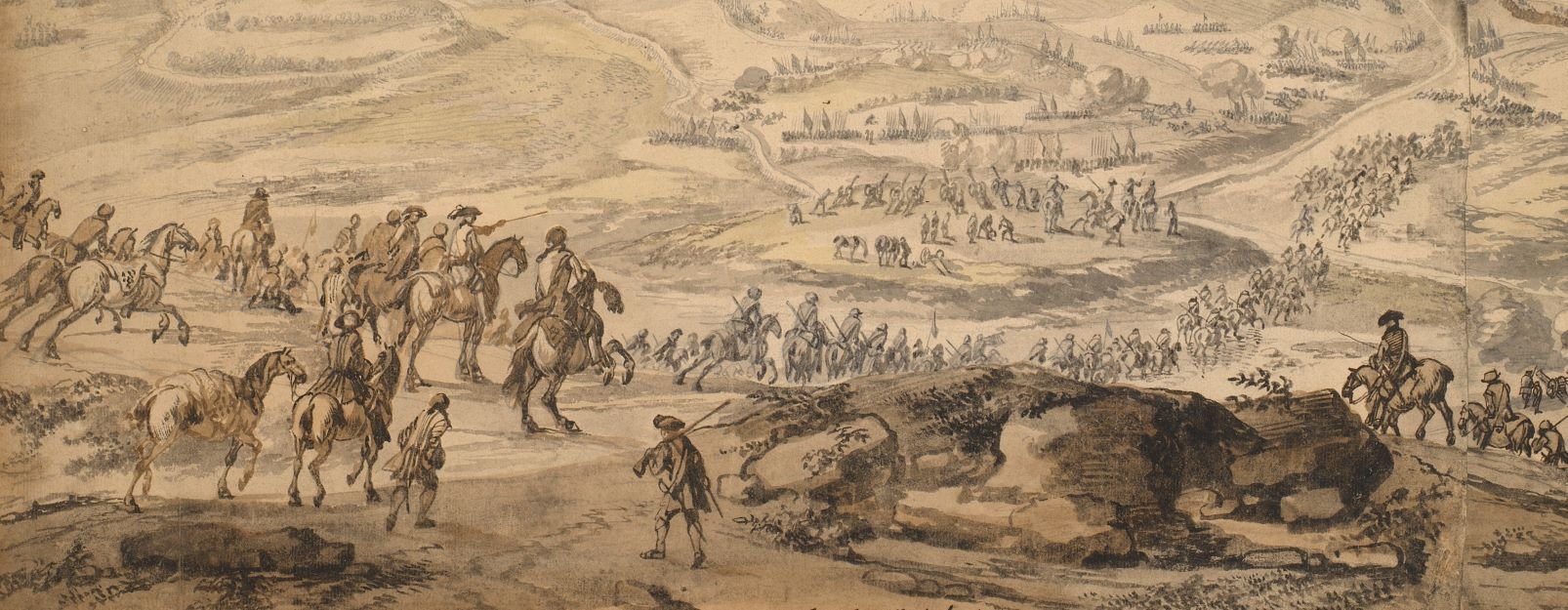
Printed and manuscript maps, prints and views of 22 seventeenth-century wars
Map of Bruges, Ostend and St André, 1696 (Brugge [Bruges], Flanders, Belgium) 51°12ʹ32ʺN 03°13ʹ27ʺE; (Oostende, Flanders, Belgium) 51°13'24"N 02°54'42"E; (Sint-Andreis [St. André], Flanders, Belgium)
1696 or laterPencil, pen, ink and watercolour on three sheets of paper, joined; laid down on linen; edged with cerise silk ribbon; one pink linen tie to left edge; a brass ring for hanging missing from top left and top right corners | Scale: not stated. 1:25,000 approx. | RCIN 724087
In August 1696, Villeroi, commanding the French in Flanders, considered the possibility of bombarding Bruges, shown to the left on this map and he began to advance with his cavalry in order to occupy a battery site at the Abbey of St André (Sint-Andreis). However Vaudemont, apprised of Villeroi's intentions by his intelligence services, arrived there first and set up camp on the site shown on this map to the east of Bruges, which is annotated: ‘Camp prise Le dix Septembre par son Altesse / Le Prince de Vaudemont’. The areas which were flooded by Vaudemont are to the south-east of the camp near Tillegem.
The map is unfinished with blank text panels top left, top right and bottom left. High and low water marks are drawn along the coast. The positions of both armies around Ostend is based on the suppositions, firstly, that the French would have to construct a ‘grande Ligne de circonvallation’ in order to master the position of the fort at Plassendall (Plassendale 51°12ʹ33ʺN 03°00ʹ09ʺE), secondly, failing that, another line of circumvallation to the south-east of Ostend and, lastly, another, shorter line of circumvallation were the French to take possession of Plassendale.
The author of this map, John Chardellou was a Huguenot military engineer and was naturalised as an English subject on 24-25 March 1699. His attestor was Lewis Petit, a military surveyor and draftsman who was to become a Board of Ordnance engineer on 23 April 1700. Chardellou had already served with the train on the summer expedition of 1692 and was listed as an engineer officer in Spain from 1707 to 1712. Chardellou was deeply interested in astronomy and corresponded with, and visited Flamsteed, the Astronomer Royal in the early eighteenth century and was made F.R.S. on 30 November 1702.
For further reading, see:
J. Childs, The Nine Years’ War and the British army, 1688-1697: the operations in the Low Countries, Manchester, 1991; reprint 2013, p.321.
E.G. Forbes (et al.), The correspondence of John Flamsteed, the first Astronomer Royal, 3 vols, Bristol, 2001, vol.3, p.82.
House of Lords Record Office HL/PO/JO/10/1/519/1423.
W. Porter, The history of the Corps of Royal Engineers, Chatham, 1951, vol.1. pp.56, 128.
Condition: nine fold lines; creased; very worn; several repairs made on verso to old tears before being laid down on linen; surface dirt; brown stains. Verso: brown stains and foxing; induced discolouration; heavy surface dirt along right edge, in a pattern consistent with the map having been stored in a roll and tied.
? John Chardellou (active 1692-1714) (draughtsman)
Subject(s)
Army-Allied army (War of the Grand Alliance, 1688-97)Army-FranceWatermark: Fleur-de-lys in crowned shield, a ‘4’ suspending the letter W below; countermark: the letters I H S [with cross] above IVILLEDARY
Condition: nine fold lines; creased; very worn; several repairs made on verso to old tears before being laid down on linen; surface dirt; brown stains. Verso: brown stains and foxing; induced discolouration; heavy surface dirt along right edge, in a pattern consistent with the map having been stored in a roll and tied
Scale: not stated. 1:25,000 approx.
61.7 x 117.9 cm (image and sheet)
Printed title:
No title
Annotations:
George III heading: [black pencil:] Ostend 1696
Other annotations: (Recto) [bottom left, black pencil:] Military; [bottom right, red pencil, faint:] [il ny a pas plus de ... ?]. (Verso) [left, below centre, ink, obscured by linen backing:] [?Canal d'] Ostende a Bruges 169[?] [and, black pencil:] 71; [bottom left, black pencil, in Schultz's or Mason's hand]: Canal d'Ostende a Brussels [strike through] Bruges 1696. XXII; [top left, ink:] N9. [or, an upside down V slash 9] XII½; [top left, black pencil:] 2; [bottom right, ink on a contemporary label:] I [with a red cross to the right]/58; [bottom, right of centre, blue biro on a 1980s Royal Library red-printed label:] IV 87.
K. Mil. dummy sheet:
[Manuscript ink:] A drawn Map of the Country between Ostend and Bruges with the Encampments and Lines of the Corps / of the Allied Army under Prince Vaudemont in Sept.r 1696 by John Chardellou. 3 Sheets / A roll … [black pencil:] 5 Table 2.d / [George III heading:] Encampments between Ostend and Bruges in Sep. 1696. no title.
Watermark: BUDGEN & WILLMOTT / 1810.
Size: 47.1 x 32.7 cm (sheet).George III catalogue entry:
Ostend A drawn Map of the Country between Ostend and Bruges with the Encampments and Lines of the Corps of the Allied Army under Prince Vaudemont in September 1696: by John Chardellou. 3 sheets.
Subject(s)
(Brugge [Bruges], Flanders, Belgium (51°12ʹ32ʺN 03°13ʹ27ʺE)
Oostende, Flanders, Belgium (51°13'24"N 02°54'42"E)
Sint-Andreis [St. André], Flanders, Belgium
Bibliographic reference(s)
J. Childs, The Nine Years’ War and the British army, 1688-1697: the operations in the Low Countries, Manchester 1991, reprint 2013, p. 321
E.G. Forbes (et al.), The correspondence of John Flamsteed, the first Astronomer Royal, 3 vols, Bristol 2001, vol. 3, p. 82
Naturalisation Act (Guy and 51 others), House of Lords Record Office HL/PO/JO/10/1/519/1423
W. Porter, The history of the Corps of Royal Engineers, Chatham 1951, vol. 1, pp. 56, 128
Page revisions
23 May 2024
Current version






